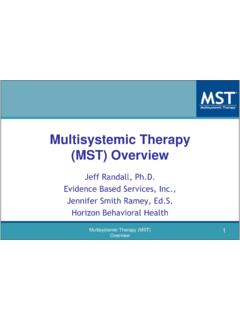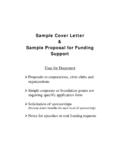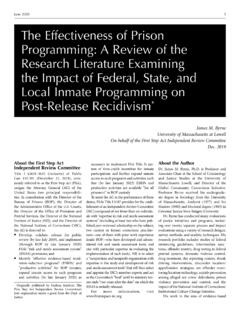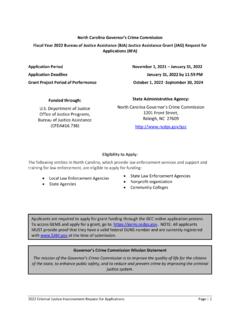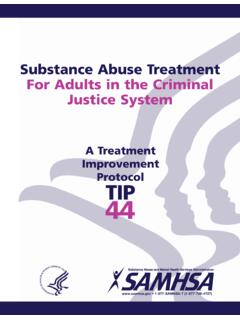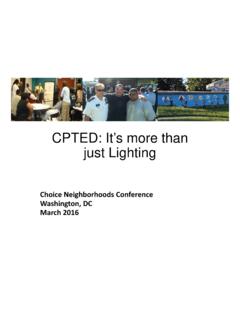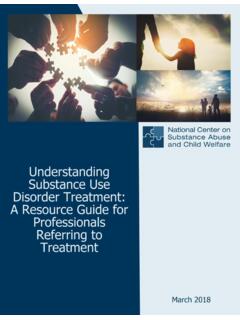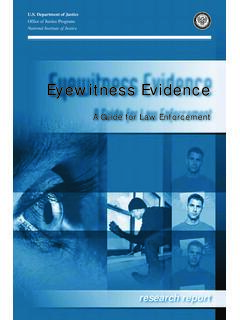Transcription of The Police and Drugs - Home | Office of Justice Programs
1 Department of Justice Office of Justice Programs National Institute of Justice September 1989 NO. 11 A publication of the National Institute of Justice , Department of Justice , and the Program in Criminal Justice Policy and Management, John F. Kennedy School of Government, Hanard University The Police and Drugs By Mark H. Moore and Mark Kleiman Many urban communities are now besieged by illegal Drugs . Fears of gang violence and muggings keep frightened residents at home. Even at home, citizens feel insecure, for drug -related break-ins and burglaries threaten. Open dealing on the street stirs the community's fears for its children. The Police sometimes seem overwhelmed. Occasionally they are outgunned. More often, they are simply overmatched by the resilience of the drug commerce. Furthermore, their potential impact is neutralized by the incapacity of the courts and penal system to mete out deserved punishments. Urgent problems and limited resources demand managerial thought for their resolution.
2 Thus, Police executives facing the drug problem might usefully consider four strategic questions: What goals might reasonably be set for drug enforcement? What parts of the Police department engage the drug problem and to what effect? What role can citizens and community groups usefully (and properly) play in coping with the problem? What basic strategies might the Police department consider as alternative attacks on the problem? The goals of drug enforcement From a Police chief's perspective, the drug problem presents distinguishable threats to community security. Most pressing is the violence associated with street-level drug dealing- This is one in a series of reports originally developed with some of the leading figures in American policing during their periodic meetings at Hanard University's John F. Kennedy School of Government. The reports are published so that Americans interested in the improvement and the future of policing can share in the information and perspectives that were part of extensive debates at the School's Executive Session on Policing.
3 The Police chiefs, mayors, scholars, and others invited to the meetings have focused on the use and promise of such strategies as community-based and problem-oriented policing. The testing and adoption of these strategies by some Police agencies signal important changes in the way American policing now does business. What these changes mean for the welfare of citizens and the fulfillment of the Police mission in the next decades has been at the heart of the Kennedy School meetings and this series of papers. We hope that through these publications Police officials and other policymakers who affect the course of policing will debate and challenge their beliefs just as those of us in the Executive Session have done. The Executive Session on Policing has been developed and administered by the Kennedy School's Program in Criminal Justice Policy and Management and funded by the National Institute of Justice and private sources that include the Charles Stewart Mott and Guggenheim Foundations.
4 James K. Stewart Director National Institute of Justice Department of Justice Mark H. Moore Faculty Chairman Program in Criminal Justice Policy and Management John F. Kennedy School of Government Harvard University particularly crack cocaine.' Much of this violence involves youth Often the violence spills over into the general population, leaving innocent victims in its wake. There is also the worry that the practice in armed, organized violence is spawning the next generation of organized Also salient is the close link between drug use and street Criminal activity is known to vary directly with levels of heroin cons~mption.~ Many of those arrested for robberies and burglaries use cocaine during the commission of their crimes or steal to support drug habik6 Among the small group of the most active and dangerous offenders, drug users are ~verrepresented.~ Thus, controlling drug use (and drug users) opens an avenue for reducing the robberies, burglaries, and petty thefts that have long been the focus of the Police .
5 A third problem is that drug use undermines the health, economic well-being, and social responsibility of drug users. It is hard to stay in school, hold onto a job, or care for a child when one is spending all one's money and attention on getting ~toned.~ The families and friends of drug users are also undermined as their resources are strained by obliga- tions to care for the drug user or to assume responsibilities that the drug user has abandoned. Fourth, drug trafficking threatens the civility of city life and undermines parenting. While parents can set rules for conduct in their own homes, the rules are hard to extend to city streets and urban classrooms where drug trafficking has become a way of life. Although these threats affect all city neighborhoods, they are perhaps worst for those in the most deprived areas. There, the capacity of the community for self-defense and the ability of parents to guide their children are not only the weakest, but also the most in need of pubric support and assi~tance.
6 ~ 66 .. drug traflcking threatens the civility of city lve and undermines parenting. 9f Fifth, the Police executive knows, even before he commits his troops, that the Police can accomplish little by them- selves. drug arrests and prosecutions are exceedingly difficult, owing to the absence of complaining victims and witnesses.'O Even with these limitations, the Police can make many more arrests than prosecutors can prosecute, courts can adjudicate, and prisons can hold." Furthermore, drug distri- bution systems, held together by the prospect of drug profits, will adapt quickly rather than collapse in the face of Police action. Finally, the Police executive knows from bitter experience that in committing his force to attack drug trafficking and drug use, he risks corruption and abuses of Informants and undercover operations-so essential to effective drug enforcement-inevitably draw Police officers into close, potentially corrupting relationships with the of- fenders they are pledged to control.
7 The frustrations of the task lead some officers to cynicism or desperate anger. As the Police become more cynical or more angry, the dealers will be standing there with cash in their pockets, ready to make a deal. Or they will mock the Police with apparent invulnerability and provoke indignant officers to plant evidence or pursue Justice through other illegal means. ((AS the Police become more cynical or more angry, the dealers will be standing there ..ready to make a deal. )) These threats define the goals of Police action against drug trafficking and use. The goals are: (1) reduce the gang violence associated with drug trafficking and prevent the emergence of powerful organized criminal groups; (2) control the street crimes committed by drug users; (3) improve the health and economic and social well-being of drug users; (4) restore the quality of life in urban communities by ending street-level drug dealing; (5) help to prevent children from experimenting with Drugs ; and (6) protect the integrity of criminal Justice institutions.
8 The operational question, of course, is how best to accom- plish these goals. Or put somewhat differently, the question is how best to deploy Police resources to produce the maximum contribution to the achievement of these goals. Police organization and deployment The narcotics bureau is generally considered the center of the Police response to drug traffkking and use. That operational unit aims directly at the source of the problem and mounts the most sophisticated investigations against drug traffickers. It also accumulates the greatest substantive knowledge about Drugs in general and in the local communitv. Although the narcotics bureau is at the center of the attack, Police strategists must recognize that other operating elements of the Police department also confront drug trafficking and use. For example, many Police departments have established specialized units to attack organized crime or criminal gangs. These units deal with narcotics trafficking because (1) the organized crime groups or gangs that are their central targets are involved in drug dealing; or (2) they have access to informants who can usefully guide narcotics investigations; or (3) they have specialized equipment that can be used in sophisticated drug investigations.
9 Regular patrol and investigative units also inevitably attack drug trafficking, use, and related violence. Insofar as their efforts are focused generally on street crime, and insofar as drug users commit a large portion of these crimes, patrol units and detectives wind up arresting a great many drug users. Regular patrol and investigative units also end up arresting some drug users for narcotics offenses such as illegal possession and use of In most cases, the person arrested will not be on probation or parole and must be tried to be punished. In other cases, however, the drug offenses will constitute probation or parole violations that could result in immediate incarceration if the local court system took such offenses seriously. drug users commit a large portion of these crimes, patrol units and detectives [arrest] many drug The patrol bureau will also be engaged in the fight against Drugs as a result of calls from citizens complaining about drug dealing in specific locations.
10 Often, in response to citizen complaints or at the initiative of the chief, special drug task forces will be formed to deal with a particularly threatening or flagrant drug These operations draw on patrol forces as well as detective units. Typically, they last for a while and then go out of existence. Somewhat more specialized are those units committed to drug education. Although drug education seems like a significant departure from the usual objectives and methods of policing, increasingly Police departments are establishing such Programs to fill a perceived void in this important demand-reducing function. l5 The point of reviewing these different lines of attack is not only to remind enforcement strategists that a Police depart- ment's overall strategy against Drugs includes far more than the activities of the narcotics bureau, but also to raise an important managerial question: who in the Police department will be responsible for designing, executing, and evaluating the department-wide drug control strategy?










